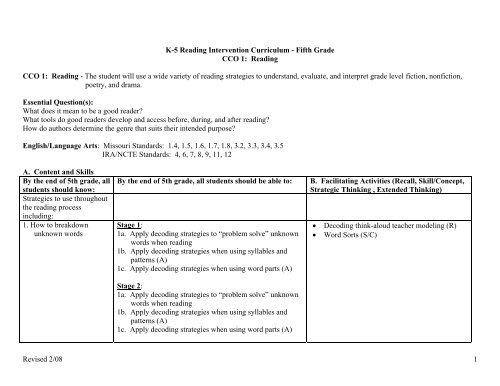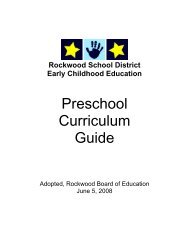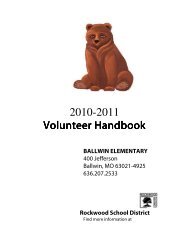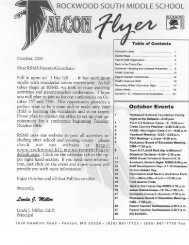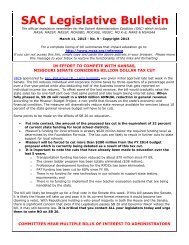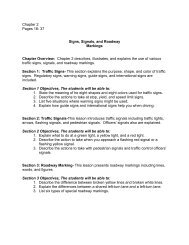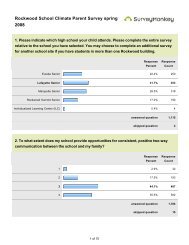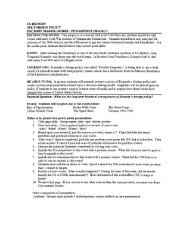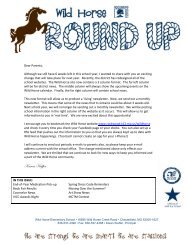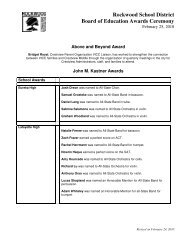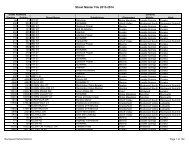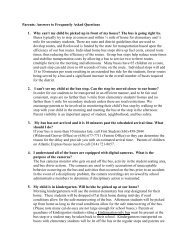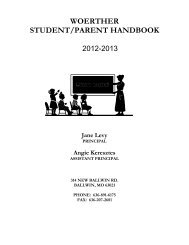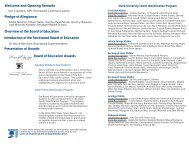5th Grade
5th Grade
5th Grade
Create successful ePaper yourself
Turn your PDF publications into a flip-book with our unique Google optimized e-Paper software.
K-5 Reading Intervention Curriculum - Fifth <strong>Grade</strong><br />
CCO 1: Reading<br />
CCO 1: Reading - The student will use a wide variety of reading strategies to understand, evaluate, and interpret grade level fiction, nonfiction,<br />
poetry, and drama.<br />
Essential Question(s):<br />
What does it mean to be a good reader?<br />
What tools do good readers develop and access before, during, and after reading?<br />
How do authors determine the genre that suits their intended purpose?<br />
English/Language Arts: Missouri Standards: 1.4, 1.5, 1.6, 1.7, 1.8, 3.2, 3.3, 3.4, 3.5<br />
IRA/NCTE Standards: 4, 6, 7, 8, 9, 11, 12<br />
A. Content and Skills<br />
By the end of <strong>5th</strong> grade, all<br />
students should know:<br />
Strategies to use throughout<br />
the reading process<br />
including:<br />
1. How to breakdown<br />
unknown words<br />
By the end of <strong>5th</strong> grade, all students should be able to:<br />
Stage 1:<br />
1a. Apply decoding strategies to “problem solve” unknown<br />
words when reading<br />
1b. Apply decoding strategies when using syllables and<br />
patterns (A)<br />
1c. Apply decoding strategies when using word parts (A)<br />
Stage 2:<br />
1a. Apply decoding strategies to “problem solve” unknown<br />
words when reading<br />
1b. Apply decoding strategies when using syllables and<br />
patterns (A)<br />
1c. Apply decoding strategies when using word parts (A)<br />
B. Facilitating Activities (Recall, Skill/Concept,<br />
Strategic Thinking , Extended Thinking)<br />
• Decoding think-aloud teacher modeling (R)<br />
• Word Sorts (S/C)<br />
Revised 2/08 1
K-5 Reading Intervention Curriculum - Fifth <strong>Grade</strong><br />
CCO 1: Reading<br />
By the end of <strong>5th</strong> grade, all<br />
students should know:<br />
1. cont. How to breakdown<br />
unknown words<br />
2. Characteristics of fluent<br />
reading<br />
By the end of <strong>5th</strong> grade, all students should be able to:<br />
Stage 3:<br />
1a. Apply decoding strategies to “problem solve” unknown<br />
words when reading<br />
1b. Apply decoding strategies when using syllables and<br />
patterns (A)<br />
1c. Apply decoding strategies when using word parts (A)<br />
Stage 1:<br />
2a. Read grade-level instructional text with accuracy (A)<br />
2b. Read grade level instructional text with expression (A),<br />
2c. Read grade level instructional text while adjusting<br />
reading rate based on type and difficulty of text (E)<br />
Stage 2:<br />
2a. Read grade-level instructional text with accuracy (A)<br />
2b. Read grade level instructional text with expression (A),<br />
2c. Read grade level instructional text while adjusting<br />
reading rate based on type and difficulty of text (E)<br />
Stage 3:<br />
2a. Read grade-level instructional text with accuracy (A)<br />
2b. Read grade level instructional text with expression (A),<br />
2c. Read grade level instructional text while adjusting<br />
reading rate based on type and difficulty of text (E)<br />
B. Facilitating Activities (Recall, Skill/Concept,<br />
Strategic Thinking , Extended Thinking)<br />
• Reader’s Theater Webquest<br />
http://mywebpages.comcast.net/dkreiger/Reade<br />
rsTheaterWebquest (R, S/C, ST, ET)<br />
• Poetry(S/C)<br />
• Singing (S/C)<br />
• Repeated readings (S/C)<br />
• Partner Reading (S/C)<br />
• Choral Reading (S/C)<br />
Revised 2/08 2
K-5 Reading Intervention Curriculum - Fifth <strong>Grade</strong><br />
CCO 1: Reading<br />
By the end of <strong>5th</strong> grade, all<br />
students should know:<br />
3. The meaning and<br />
relationships of 5 th grade<br />
vocabulary words<br />
By the end of <strong>5th</strong> grade, all students should be able to:<br />
Stage 1:<br />
3a. Develop vocabulary through text using roots and affixes<br />
(prefixes and suffixes) (D)<br />
3b. Develop vocabulary through text using context clues (E)<br />
3c. Develop vocabulary through text using glossary,<br />
dictionary, and thesaurus (DE)<br />
3d. Develop vocabulary through text using synonyms,<br />
antonyms, homographs, and homophones (D)<br />
3e. Develop vocabulary through text using multi-meaning<br />
words (E)<br />
Stage 2:<br />
3a. Develop vocabulary through text using roots and affixes<br />
(prefixes and suffixes) (D)<br />
3b. Develop vocabulary through text using context clues (E)<br />
3c. Develop vocabulary through text using glossary,<br />
dictionary, and thesaurus (DE)<br />
3d. Develop vocabulary through text using synonyms,<br />
antonyms, homographs, and homophones (D)<br />
3e. Develop vocabulary through text using multi-meaning<br />
words (E)<br />
3f. Develop vocabulary through text using simple analogies<br />
(D)<br />
3g. Develop vocabulary through text using content area<br />
words (E)<br />
3h. Develop vocabulary through text using common<br />
academic vocabulary (see grade level list) (D)<br />
B. Facilitating Activities (Recall, Skill/Concept,<br />
Strategic Thinking , Extended Thinking)<br />
• Visual Boxing (Divide a box into four boxes,<br />
Top left box is the word, top right illustrate,<br />
bottom left use in a sentence, bottom right give<br />
an antonym) (S/C)<br />
• *Guess the covered word (context) (S/C)<br />
• Vocabulary charades (S/C)<br />
• Word wall – “delicious” words (S/C)<br />
Revised 2/08 3
K-5 Reading Intervention Curriculum - Fifth <strong>Grade</strong><br />
CCO 1: Reading<br />
By the end of <strong>5th</strong> grade, all<br />
students should know:<br />
3. cont. The meaning and<br />
relationships of 5 th grade<br />
vocabulary words<br />
4. Comprehension<br />
strategies before reading<br />
By the end of <strong>5th</strong> grade, all students should be able to:<br />
Stage 3:<br />
3a. Develop vocabulary through text using roots and affixes<br />
(prefixes and suffixes) (D)<br />
3b. Develop vocabulary through text using context clues (E)<br />
3c. Develop vocabulary through text using glossary,<br />
dictionary, and thesaurus (DE)<br />
3d. Develop vocabulary through text using synonyms,<br />
antonyms, homographs, and homophones (D)<br />
3e. Develop vocabulary through text using multi-meaning<br />
words (E)<br />
3f. Develop vocabulary through text using simple analogies<br />
(D)<br />
3g. Develop vocabulary through text using content area<br />
words (E)<br />
3h. Develop vocabulary through text using common<br />
academic vocabulary (see grade level list) (D)<br />
Stage 1:<br />
4a. Apply pre-reading strategies to aid comprehension<br />
through activating prior knowledge (D)<br />
4b. Apply pre-reading strategies to aid comprehension<br />
through previewing (A)<br />
4c. Apply pre-reading strategies to aid comprehension<br />
through predicting (E)<br />
4d. Apply pre-reading strategies to aid comprehension<br />
through setting a purpose for reading (A)<br />
4e. Apply pre-reading strategies to aid comprehension<br />
through recognizing text features of genres (poetry,<br />
fiction, nonfiction, plays) (A)<br />
B. Facilitating Activities (Recall, Skill/Concept,<br />
Strategic Thinking , Extended Thinking)<br />
•<br />
• KWL (S/C)<br />
• Picture walk, Text structure preview (S/C)<br />
• Graphic organizers (compare-contrast,<br />
problem-solution, cause-effect, sequencing)<br />
(S/C, ST)<br />
• Think Pair Share (S/C)<br />
• Build background through narrow reading (ST)<br />
• ERT (Everybody Reads To…) (R)<br />
• Anticipation Guide (S/C<br />
Revised 2/08 4
K-5 Reading Intervention Curriculum - Fifth <strong>Grade</strong><br />
CCO 1: Reading<br />
By the end of <strong>5th</strong> grade, all<br />
students should know:<br />
4. cont. Comprehension<br />
strategies before reading<br />
By the end of <strong>5th</strong> grade, all students should be able to:<br />
Stage 2:<br />
4a. Apply pre-reading strategies to aid comprehension<br />
through activating prior knowledge (D)<br />
4b. Apply pre-reading strategies to aid comprehension<br />
through previewing (A)<br />
4c. Apply pre-reading strategies to aid comprehension<br />
through predicting (E)<br />
4d. Apply pre-reading strategies to aid comprehension<br />
through setting a purpose for reading (A)<br />
4e. Apply pre-reading strategies to aid comprehension<br />
through recognizing text features of genres (poetry,<br />
fiction, nonfiction, plays) (A)<br />
Stage 3:<br />
4a. Apply pre-reading strategies to aid comprehension<br />
through activating prior knowledge (D)<br />
4b. Apply pre-reading strategies to aid comprehension<br />
through previewing (A)<br />
4c. Apply pre-reading strategies to aid comprehension<br />
through predicting (E)<br />
4d. Apply pre-reading strategies to aid comprehension<br />
through setting a purpose for reading (A)<br />
4e. Apply pre-reading strategies to aid comprehension<br />
through recognizing text features of genres (poetry,<br />
fiction, nonfiction, plays) (A)<br />
B. Facilitating Activities (Recall, Skill/Concept,<br />
Strategic Thinking , Extended Thinking)<br />
Revised 2/08 5
K-5 Reading Intervention Curriculum - Fifth <strong>Grade</strong><br />
CCO 1: Reading<br />
By the end of <strong>5th</strong> grade, all<br />
students should know:<br />
5. Comprehension strategies<br />
during reading<br />
By the end of <strong>5th</strong> grade, all students should be able to:<br />
Stage 1:<br />
5a. Apply strategies during reading to determine and clarify<br />
meaning of unknown words (E)<br />
5b. Apply strategies during reading to self monitor accuracy<br />
and understanding (E)<br />
5c. Apply strategies during reading to question the text to<br />
clarify (E)<br />
5d. Apply strategies during reading to reflect and respond to<br />
questions with text based support during reading(A)<br />
5e. Apply strategies during reading to infer/ draw<br />
conclusions (DE)<br />
5f. Apply strategies during reading to visualize/ make<br />
mental images (D)<br />
5g. Apply strategies during reading to retell including<br />
characters, setting, problem/solution, or topic, main idea,<br />
and detail (D)<br />
5h. Apply strategies during reading to paraphrase (E)<br />
5i. Apply strategies during reading to summarize (E)<br />
5j. Apply strategies during reading to identify/ Interpret<br />
narrative elements (beginning, middle, end, characters,<br />
setting, problem, solution, events) (A)<br />
5k. Apply strategies during reading to use text structure<br />
(titles, headings, visuals, captions, bold face words) (E)<br />
5l. Apply strategies during reading to make and confirm text<br />
based predictions (A)<br />
5m. Apply strategies during reading to connect to main<br />
ideas text features (graphics, sequence, maps, diagrams,<br />
charts and index) (E) *ALA*<br />
B. Facilitating Activities (Recall, Skill/Concept,<br />
Strategic Thinking , Extended Thinking)<br />
• Use vocabulary organizer to learn new words<br />
(S/C)<br />
• Utilize reciprocal teaching model to clarify,<br />
generate, predict, and summarize (ST)<br />
• Identify covered or unfamiliar words using<br />
context clues (guess the covered word) (S/C)<br />
• Use a graphic organizer to identify story<br />
elements (S/C)<br />
• Use the “think aloud” strategy to clarify text (R)<br />
• See “103 Things to Do Before, During and<br />
After Reading” in the Appendix for appropriate<br />
activities<br />
• Code/annotate text with post its during read<br />
aloud (S/C)<br />
• Use three facts and a fib (R)<br />
• Everyone Reads To (find out) (R)<br />
• Keep a reading journal using Interactive Notes<br />
(R)<br />
• Self-evaluate independent reading (S/C)<br />
• Use Question-Answer Relationship (Right<br />
There, Think and Search, Author and You, On<br />
My Own) (ST)<br />
• Use Reciprocal Teaching strategies (clarifying,<br />
questioning, predicting, summarizing) (ST)<br />
Revised 2/08 6
K-5 Reading Intervention Curriculum - Fifth <strong>Grade</strong><br />
CCO 1: Reading<br />
By the end of <strong>5th</strong> grade, all<br />
students should know:<br />
5. cont. Comprehension<br />
strategies during reading<br />
By the end of <strong>5th</strong> grade, all students should be able to:<br />
Stage 2:<br />
5a. Apply strategies during reading to determine and clarify<br />
meaning of unknown words (E)<br />
5b. Apply strategies during reading to self monitor accuracy<br />
and understanding (E)<br />
5c. Apply strategies during reading to question the text to<br />
clarify (E)<br />
5d. Apply strategies during reading to reflect and respond to<br />
questions with text based support during reading(A)<br />
5e. Apply strategies during reading to infer/ draw<br />
conclusions (DE)<br />
5f. Apply strategies during reading to visualize/ make<br />
mental images (D)<br />
5g. Apply strategies during reading to retell including<br />
characters, setting, problem/solution, or topic, main idea,<br />
and detail (D)<br />
5h. Apply strategies during reading to paraphrase (E)<br />
5i. Apply strategies during reading to summarize (E)<br />
5j. Apply strategies during reading to identify/ Interpret<br />
narrative elements (beginning, middle, end, characters,<br />
setting, problem, solution, events) (A)<br />
5k. Apply strategies during reading to use text structure<br />
(titles, headings, visuals, captions, bold face words) (E)<br />
5l. Apply strategies during reading to make and confirm text<br />
based predictions (A)<br />
5m. Apply strategies during reading to connect to main<br />
ideas text features (graphics, sequence, maps, diagrams,<br />
charts and index) (E) *ALA*<br />
B. Facilitating Activities (Recall, Skill/Concept,<br />
Strategic Thinking , Extended Thinking)<br />
Revised 2/08 7
K-5 Reading Intervention Curriculum - Fifth <strong>Grade</strong><br />
CCO 1: Reading<br />
By the end of <strong>5th</strong> grade, all<br />
students should know:<br />
5. cont. Comprehension<br />
strategies during reading<br />
By the end of <strong>5th</strong> grade, all students should be able to:<br />
Stage 3:<br />
5a. Apply strategies during reading to determine and clarify<br />
meaning of unknown words (E)<br />
5b. Apply strategies during reading to self monitor accuracy<br />
and understanding (E)<br />
5c. Apply strategies during reading to question the text to<br />
clarify (E)<br />
5d. Apply strategies during reading to reflect and respond to<br />
questions with text based support during reading(A)<br />
5e. Apply strategies during reading to infer/ draw<br />
conclusions (DE)<br />
5f. Apply strategies during reading to visualize/ make<br />
mental images (D)<br />
5g. Apply strategies during reading to retell including<br />
characters, setting, problem/solution, or topic, main idea,<br />
and detail (D)<br />
5h. Apply strategies during reading to paraphrase (E)<br />
5i. Apply strategies during reading to summarize (E)<br />
5j. Apply strategies during reading to identify/ Interpret<br />
narrative elements (beginning, middle, end, characters,<br />
setting, problem, solution, events) (A)<br />
5k. Apply strategies during reading to use text structure<br />
(titles, headings, visuals, captions, bold face words) (E)<br />
5l. Apply strategies during reading to make and confirm text<br />
based predictions (A)<br />
5m. Apply strategies during reading to connect to main<br />
ideas text features (graphics, sequence, maps, diagrams,<br />
charts and index) (E) *ALA*<br />
B. Facilitating Activities (Recall, Skill/Concept,<br />
Strategic Thinking , Extended Thinking)<br />
Revised 2/08 8
K-5 Reading Intervention Curriculum - Fifth <strong>Grade</strong><br />
CCO 1: Reading<br />
By the end of <strong>5th</strong> grade, all<br />
students should know:<br />
6. Comprehension strategies<br />
after reading<br />
By the end of <strong>5th</strong> grade, all students should be able to:<br />
Stage 1:<br />
6a. Apply post-reading skills to comprehend and interpret<br />
text by confirming/ rejecting predictions (A)<br />
6b. Apply post reading skills to comprehend and interpret<br />
text by questioning to clarify (E)<br />
6c. Apply post-reading skills to comprehend and interpret<br />
text by reflecting and responding to questions with text<br />
based support (A)<br />
6d. Apply post-reading skills to comprehend and interpret<br />
text by drawing conclusions/inferring (E)<br />
6e. Apply post-reading skills to comprehend and interpret<br />
text by analyzing (DE)<br />
6f. Apply post-reading skills to comprehend and interpret<br />
text by summarizing (E)<br />
6g. Apply post-reading skills to comprehend and interpret<br />
text by paraphrasing (E)<br />
6h. Apply post-reading skills to comprehend and interpret<br />
text by explaining main idea and supporting details (A)<br />
6i. Apply post-reading skills to comprehend and interpret<br />
text by identifying and sequence events (E)<br />
6j. Apply post-reading skills to comprehend and interpret<br />
text by identifying and explain cause and effect (A)<br />
6k. Apply post-reading skills to comprehend and interpret<br />
text by comparing and contrasting (A)<br />
6l. Apply post-reading skills to comprehend and interpret<br />
text by evaluating the accuracy of information (D)<br />
6m. Apply post-reading skills to comprehend and interpret<br />
text by identifying and interpreting author’s ideas and<br />
purpose (DE)<br />
B. Facilitating Activities (Recall, Skill/Concept,<br />
Strategic Thinking , Extended Thinking)<br />
• Utilize SQ3R, QAR, KWL to monitor and<br />
develop comprehension *see appendix(ST)<br />
• Interpret a story element by creating an<br />
illustration (S/C)<br />
• Identify and summarize the major events of<br />
story in a journal or reading log entry (S/C)<br />
• Conduct a Socratic Seminar (ST)<br />
• Construct a T-chart to identify main idea and<br />
supporting details (ST)<br />
• Construct a sequel chapter or paragraph to a<br />
story (ST)<br />
• Create a product that shows understanding of a<br />
story or book/genre (ST)<br />
• Student/teacher independent reading<br />
conferences (ST)<br />
• Write a gist summary ((S/C)<br />
• Make a story pyramid to summarize a story<br />
Revised 2/08 9
K-5 Reading Intervention Curriculum - Fifth <strong>Grade</strong><br />
CCO 1: Reading<br />
By the end of <strong>5th</strong> grade, all<br />
students should know:<br />
6. cont. Comprehension<br />
strategies after reading<br />
By the end of <strong>5th</strong> grade, all students should be able to:<br />
Stage 2:<br />
6a. Apply post-reading skills to comprehend and interpret<br />
text by confirming/ rejecting predictions (A)<br />
6b. Apply post reading skills to comprehend and interpret<br />
text by questioning to clarify (E)<br />
6c. Apply post-reading skills to comprehend and interpret<br />
text by reflecting and responding to questions with text<br />
based support (A)<br />
6d. Apply post-reading skills to comprehend and interpret<br />
text by drawing conclusions/inferring (E)<br />
6e. Apply post-reading skills to comprehend and interpret<br />
text by analyzing (DE)<br />
6f. Apply post-reading skills to comprehend and interpret<br />
text by summarizing (E)<br />
6g. Apply post-reading skills to comprehend and interpret<br />
text by paraphrasing (E)<br />
6h. Apply post-reading skills to comprehend and interpret<br />
text by explaining main idea and supporting details (A)<br />
6i. Apply post-reading skills to comprehend and interpret<br />
text by identifying and sequence events (E)<br />
6j. Apply post-reading skills to comprehend and interpret<br />
text by identifying and explain cause and effect (A)<br />
6k. Apply post-reading skills to comprehend and interpret<br />
text by comparing and contrasting (A)<br />
6l. Apply post-reading skills to comprehend and interpret<br />
text by evaluating the accuracy of information (D)<br />
6m. Apply post-reading skills to comprehend and interpret<br />
text by identifying and interpreting author’s ideas and<br />
purpose (DE)<br />
B. Facilitating Activities (Recall, Skill/Concept,<br />
Strategic Thinking , Extended Thinking)<br />
Revised 2/08 10
K-5 Reading Intervention Curriculum - Fifth <strong>Grade</strong><br />
CCO 1: Reading<br />
By the end of <strong>5th</strong> grade, all<br />
students should know:<br />
6. cont. Comprehension<br />
strategies after reading<br />
By the end of <strong>5th</strong> grade, all students should be able to:<br />
Stage 3:<br />
6a. Apply post-reading skills to comprehend and interpret<br />
text by confirming/ rejecting predictions (A)<br />
6b. Apply post reading skills to comprehend and interpret<br />
text by questioning to clarify (E)<br />
6c. Apply post-reading skills to comprehend and interpret<br />
text by reflecting and responding to questions with text<br />
based support (A)<br />
6d. Apply post-reading skills to comprehend and interpret<br />
text by drawing conclusions/inferring (E)<br />
6e. Apply post-reading skills to comprehend and interpret<br />
text by analyzing (DE)<br />
6f. Apply post-reading skills to comprehend and interpret<br />
text by summarizing (E)<br />
6g. Apply post-reading skills to comprehend and interpret<br />
text by paraphrasing (E)<br />
6h. Apply post-reading skills to comprehend and interpret<br />
text by explaining main idea and supporting details (A)<br />
6i. Apply post-reading skills to comprehend and interpret<br />
text by identifying and sequence events (E)<br />
6j. Apply post-reading skills to comprehend and interpret<br />
text by identifying and explain cause and effect (A)<br />
6k. Apply post-reading skills to comprehend and interpret<br />
text by comparing and contrasting (A)<br />
6l. Apply post-reading skills to comprehend and interpret<br />
text by evaluating the accuracy of information (D)<br />
6m. Apply post-reading skills to comprehend and interpret<br />
text by identifying and interpreting author’s ideas and<br />
purpose (DE)<br />
B. Facilitating Activities (Recall, Skill/Concept,<br />
Strategic Thinking , Extended Thinking)<br />
Revised 2/08 11
K-5 Reading Intervention Curriculum - Fifth <strong>Grade</strong><br />
CCO 1: Reading<br />
By the end of <strong>5th</strong> grade, all By the end of <strong>5th</strong> grade, all students should be able to:<br />
students should know:<br />
7. Making Connections Stage 1:<br />
7a. Compare, contrast, and analyze connections between<br />
information and relationships in various fiction and<br />
nonfiction works (text to text) (A)<br />
7b. Compare, contrast, and analyze connections between<br />
text ideas and own experiences (text to self) (A)<br />
7c. Compare, contrast, and analyze connections between<br />
text ideas and the world by responding to literature that<br />
reflects a culture and historic time frame (text to world)<br />
(A)<br />
7d. Generate questions while reading<br />
7e. Self-monitor for understanding<br />
7f. Self-correct if reading doesn’t make sense<br />
B. Facilitating Activities (Recall, Skill/Concept,<br />
Strategic Thinking , Extended Thinking)<br />
• Coding or annotation of text (with post-its)<br />
(S/C)<br />
• Text connections graphic organizer (appendix)<br />
(S/C)<br />
• Double column notes (appendix) (S/C)<br />
Stage 2:<br />
7a. Compare, contrast, and analyze connections between<br />
information and relationships in various fiction and<br />
nonfiction works (text to text) (A)<br />
7b. Compare, contrast, and analyze connections between<br />
text ideas and own experiences (text to self) (A)<br />
7c. Compare, contrast, and analyze connections between<br />
text ideas and the world by responding to literature that<br />
reflects a culture and historic time frame (text to world)<br />
(A)<br />
7d. Generate questions while reading<br />
7e. Self-monitor for understanding<br />
7f. Self-correct if reading doesn’t make sense<br />
Revised 2/08 12
By the end of <strong>5th</strong> grade, all<br />
students should know:<br />
7. cont. Making<br />
Connections<br />
K-5 Reading Intervention Curriculum - Fifth <strong>Grade</strong><br />
CCO 1: Reading<br />
By the end of <strong>5th</strong> grade, all students should be able to:<br />
Stage 3:<br />
7a. Compare, contrast, and analyze connections between<br />
information and relationships in various fiction and<br />
nonfiction works (text to text) (A)<br />
7b. Compare, contrast, and analyze connections between<br />
text ideas and own experiences (text to self) (A)<br />
7c. Compare, contrast, and analyze connections between<br />
text ideas and the world by responding to literature that<br />
reflects a culture and historic time frame (text to world)<br />
(A)<br />
7d. Generate questions while reading<br />
7e. Self-monitor for understanding<br />
7f. Self-correct if reading doesn’t make sense<br />
1. Genre Stage 1:<br />
1a. Expose author techniques while making inferences about<br />
setting, character traits, problem and solution and story<br />
events (E)<br />
1b. Interpret poetry on literal and figurative levels (D)<br />
Stage 2:<br />
1a. Identify author techniques while reading mentor text<br />
(author study) (D)<br />
1b. Expose author techniques while making inferences about<br />
setting, character traits, problem and solution and story<br />
events (E)<br />
1c. Expose author techniques while comparing and<br />
contrasting various literary elements (A)<br />
1d. Expose author techniques while explaining author’s<br />
purpose (E)<br />
1e. Interpret poetry on literal and figurative levels (D)<br />
B. Facilitating Activities (Recall, Skill/Concept,<br />
Strategic Thinking , Extended Thinking)<br />
• Teacher/student book talks (ST)<br />
• Favorite books display “bucket of books”<br />
(S/C)<br />
• Author study (ST)<br />
• Poem of the week (R)<br />
• Poetry visualization (ST)<br />
Revised 2/08 13
K-5 Reading Intervention Curriculum - Fifth <strong>Grade</strong><br />
CCO 1: Reading<br />
By the end of <strong>5th</strong> grade, all By the end of <strong>5th</strong> grade, all students should be able to:<br />
students should know:<br />
1. Genre Stage 3:<br />
1a. Identify author techniques while reading mentor text<br />
(author study) (D)<br />
1b. Expose author techniques while making inferences about<br />
setting, character traits, problem and solution and story<br />
events (E)<br />
1c. Expose author techniques while comparing and<br />
contrasting various literary elements (A)<br />
1d. Expose author techniques while explaining author’s<br />
purpose (E)<br />
1e. Interpret poetry on literal and figurative levels (D)<br />
2. Literary techniques Stage 3:<br />
2a. Explain examples of literary techniques in text and<br />
emphasizing:<br />
• Simile (E)<br />
• Metaphor (E)<br />
• Personification (E)<br />
B. Facilitating Activities (Recall, Skill/Concept,<br />
Strategic Thinking , Extended Thinking)<br />
• Poet study (R, S/C, ST)<br />
• Write/illustrate similes and metaphors (literal<br />
vs. figurative) (ST, ET)<br />
• Flipbook –id and illustrate similes, metaphors,<br />
and personification (S/C ST)<br />
• Id similes and metaphors personification in<br />
other works fiction vs. nonfiction identify<br />
author’s purpose (S/C, ST)<br />
Revised 2/08 14
K-5 Reading Intervention Curriculum - Fifth <strong>Grade</strong><br />
CCO 1: Reading<br />
C. Application Level Assessment (ALA)<br />
Stage 1<br />
1. Student will score 90-94% word accuracy<br />
2. Student will score 80% comprehension<br />
Stage 2:<br />
1. Student will score 90-94% word accuracy<br />
2. Student will score 80% comprehension<br />
Stage 3:<br />
1. Student will score 90-94% word accuracy<br />
2. Student will score 80% comprehension<br />
D. Exit Criteria<br />
Stage 1:<br />
1. Student will read less than one year below grade level with 90-94% decoding accuracy<br />
2. Student will answer explicit/implicit comprehension questions with 80% accuracy<br />
3. Student will score less than one year below grade level (GE) on the STAR<br />
Stage 2:<br />
1. Student will read less than six months below grade level with 90-94% decoding accuracy<br />
2. Student will answer explicit/implicit comprehension questions with 80% accuracy<br />
3. Student will score less than six months below grade level (GE) on the STAR<br />
Stage 3:<br />
1. Student will read a grade level passage with 90-94% accuracy<br />
2. Student will answer explicit/implicit comprehension questions with 80% accuracy<br />
3. Student will score at grade level on the STAR<br />
Revised 2/08 15
4. Advanced<br />
Always…<br />
3. Proficient<br />
Consistently<br />
Elementary Reading Scoring Guide <strong>Grade</strong>s 1-5<br />
Fluency Comprehension Strategic Reading* Independent Reading<br />
In text at or above grade level: In text at or above grade level: In text at or above grade level: In text above grade level:<br />
_ reads accurately<br />
_ retells and summarizes text _ uses multiple strategies to read _ completes books<br />
_ reads orally at a pace<br />
_ completes graphic organizers to and understand<br />
_ can discuss books<br />
comparable with talking<br />
show understanding<br />
_ monitors accuracy and selfcorrects<br />
_ selects ‘just right’books<br />
_ reads with expression that _ contributes to discussions<br />
mistakes<br />
_ understands books read<br />
accurately interprets the text _ answers questions completely _ monitors understanding while independently<br />
with text –based support<br />
reading; repairs misunderstanding<br />
In text at grade level:<br />
In text at grade level:<br />
In text at grade level:<br />
In text at grade level:<br />
_ reads accurately<br />
_ retells and summarizes text _ uses multiple strategies to read _ completes books<br />
_ reads orally at a pace<br />
_ completes graphic organizers to and understand<br />
_ can discuss books<br />
comparable with talking<br />
show understanding<br />
_ monitors accuracy and selfcorrects<br />
_ selects ‘just right’books<br />
_ reads with expression that _ contributes to discussions<br />
mistakes<br />
_ understands books read<br />
accurately interprets the text _ answers questions completely _ monitors understanding while independently<br />
with text –based support<br />
reading; repairs misunderstanding<br />
2. Basic<br />
Sometimes…<br />
1. Below Basic<br />
Seldom…<br />
In text at grade level:<br />
_ reads accurately<br />
_ reads orally at a pace<br />
comparable with talking<br />
_ reads with expression that<br />
accurately interprets the text<br />
In text at grade level:<br />
_ reads accurately<br />
_ reads orally at a pace<br />
comparable with talking<br />
_ reads with expression that<br />
accurately interprets the text<br />
In text at grade level:<br />
_ retells and summarizes text<br />
_ completes graphic organizers to<br />
show understanding<br />
_ contributes to discussions<br />
_ answers questions completely<br />
with text –based support<br />
In text at grade level:<br />
_ retells and summarizes text<br />
_ completes graphic organizers to<br />
show understanding<br />
_ contributes to discussions<br />
_ answers questions completely<br />
with text –based support<br />
In text at grade level:<br />
_ uses multiple strategies to read<br />
and understand<br />
_ monitors accuracy and selfcorrects<br />
mistakes<br />
_ monitors understanding while<br />
reading; repairs misunderstanding<br />
In text at grade level:<br />
_ uses multiple strategies to read<br />
and understand<br />
_ monitors accuracy and selfcorrects<br />
mistakes<br />
_ monitors understanding while<br />
reading; repairs misunderstanding<br />
In text at grade level:<br />
_ completes books<br />
_ can discuss books<br />
_ selects ‘just right’books<br />
_ understands books read<br />
independently<br />
In text at grade level:<br />
_ completes books<br />
_ can discuss books<br />
_ selects ‘just right’books<br />
_ understands books read<br />
independently<br />
Level 4 – student always completes assigned and independent reading with no support and a high level of understanding. Level 3 – student is consistent and completes<br />
assigned and independent reading with adequate comprehension and little support. Level 2 – student is inconsistent and still needs reminders and support to complete<br />
assigned and independent reading; demonstrates incomplete understanding. Level 1 – student needs frequent reminders and significant support to complete assigned and<br />
independent reading; demonstrates limited understanding.<br />
* Strategies include visualizing, inferring/predicting, summarizing, questioning, connecting, synthesizing, and clarifying/fix-up<br />
Revised 2/08 16
K-5 Reading Intervention Curriculum - Fifth <strong>Grade</strong><br />
CCO 2: Writing<br />
CCO 2: Writing - Using the writing process and 6 Traits terminology the student will produce narrative, expository, and persuasive pieces to<br />
communicate for a variety of purposes<br />
Essential Question(s):<br />
What does it mean to be a good writer?<br />
What rules must writers be mindful of as they compose text?<br />
What tools do writers use to impact and provoke their readers?<br />
English/Language Arts Standards: Missouri Standards: 1.4, 1.8, 2.1, 2.2, 2.3, 2.4<br />
IRA/NCTE Standards: 6<br />
A. Content and Skills<br />
A. Content and Skills<br />
By the end of <strong>5th</strong> grade, all<br />
students should know:<br />
1. How to use the writing<br />
process when composing<br />
text<br />
By the end of <strong>5th</strong> grade, all students should be able to:<br />
Stage 1:<br />
1a. Generate a thought orally before writing<br />
1b. Count words in sentences<br />
1c. Use writing process, Think it (brainstorm and organize),<br />
Say it (verbalize), Write it (encoding a draft), Read it<br />
(revise), Check it (edit)<br />
1d. Write in response to text read<br />
Stage 2:<br />
1a. Use writing process, Think it (brainstorm and organize),<br />
Say it (verbalize), Write it (encoding a draft), Read it<br />
(revise), Check it (edit)<br />
1b. Write in response to text read<br />
B. Facilitating Activities (Recall, Skill/Concept,<br />
Strategic Thinking , Extended Thinking)<br />
• Inspiration<br />
• Writer’s Notebook<br />
• Editing checklist<br />
• Colored revision checklist<br />
Revised 2/08 17
K-5 Reading Intervention Curriculum - Fifth <strong>Grade</strong><br />
CCO 2: Writing<br />
By the end of <strong>5th</strong> grade, all<br />
students should know:<br />
1. cont. How to use the<br />
writing process when<br />
composing text<br />
How to compose welldeveloped<br />
text using the<br />
traits of writing:<br />
1. Voice(the heart and soul,<br />
the “sparkle”, the wit,<br />
along with the feeling<br />
and conviction of the<br />
individual writer coming<br />
out through the words)<br />
**<br />
By the end of <strong>5th</strong> grade, all students should be able to:<br />
Stage 3:<br />
1a. Use writing process, Think it (brainstorm and organize),<br />
Say it (verbalize), Write it (encoding a draft), Read it<br />
(revise), Check it (edit)<br />
1b. Write in response to text read<br />
Stage 1:<br />
1a. Develop Six Traits of Writing Skills (ideas, organization<br />
and conventions)<br />
1b. Read the question and find key words that tell you what<br />
the question is asking you to do. Ask yourself how many<br />
parts the question has.<br />
1c. Restate the question in your answer.<br />
1d. Think about where to find the answer.<br />
1e. Use details or reasons from the story to support your<br />
answer.<br />
1f. Check your answers by rereading it.<br />
__ Answer all parts of the question fully.<br />
__ Use names instead of “he,” “she,” or “it.”<br />
__ Use proper conventions.<br />
Stage 2:<br />
1a. Develop Six Traits of Writing Skills (ideas, organization<br />
and conventions)<br />
1b. Read the question and find key words that tell you what<br />
the question is asking you to do. Ask yourself how many<br />
parts the question has.<br />
B. Facilitating Activities (Recall, Skill/Concept,<br />
Strategic Thinking , Extended Thinking)<br />
• Reinforce Six Traits of Writing Skills (ideas,<br />
organization and conventions)<br />
Revised 2/08 18
K-5 Reading Intervention Curriculum - Fifth <strong>Grade</strong><br />
CCO 2: Writing<br />
By the end of <strong>5th</strong> grade, all<br />
students should know:<br />
How to compose welldeveloped<br />
text using the<br />
traits of writing:<br />
1. cont. Voice(the heart<br />
and soul, the “sparkle”,<br />
the wit, along with the<br />
feeling and conviction of<br />
the individual writer<br />
coming out through the<br />
words) **<br />
By the end of <strong>5th</strong> grade, all students should be able to:<br />
1c. Restate the question in your answer.<br />
1d. Think about where to find the answer.<br />
1e. Use details or reasons from the story to support your<br />
answer.<br />
1f. Check your answers by rereading it.<br />
__ Answer all parts of the question fully.<br />
__ Use names instead of “he,” “she,” or “it.”<br />
__ Use proper conventions.<br />
Stage 3:<br />
1a. Develop Six Traits of Writing Skills (ideas, organization<br />
and conventions)<br />
1b. Read the question and find key words that tell you what<br />
the question is asking you to do. Ask yourself how many<br />
parts the question has.<br />
1c. Restate the question in your answer.<br />
1d. Think about where to find the answer.<br />
1e. Use details or reasons from the story to support your<br />
answer.<br />
1f. Check your answers by rereading it.<br />
__ Answer all parts of the question fully.<br />
__ Use names instead of “he,” “she,” or “it.”<br />
__ Use proper conventions.<br />
B. Facilitating Activities (Recall, Skill/Concept,<br />
Strategic Thinking , Extended Thinking)<br />
Revised 2/08 19
K-5 Reading Intervention Curriculum - Fifth <strong>Grade</strong><br />
CCO 2: Writing<br />
By the end of <strong>5th</strong> grade, all<br />
students should know:<br />
How to compose welldeveloped<br />
text using the<br />
traits of writing:<br />
2. Ideas and Content (the<br />
heart of the message, the<br />
content of the piece, the<br />
main theme, together<br />
with the details that<br />
enrich and develop that<br />
theme)**<br />
3. Organization (the<br />
internal structure of a<br />
piece of writing, the<br />
thread of central<br />
meaning, the logical and<br />
sometimes intriguing<br />
pattern of the ideas) **<br />
4. Sentence Fluency (the<br />
rhythm and flow of the<br />
language, the sound of<br />
word patterns, the way<br />
in which the writing<br />
plays to the ear- not just<br />
to the eye)**<br />
By the end of <strong>5th</strong> grade, all students should be able to:<br />
Stage 1:<br />
4a. Compose text with a variety of sentence lengths (DE)<br />
4b. Compose texts with complete sentences (DE)<br />
Stage 2:<br />
4a. Compose text with a variety of sentence lengths (DE)<br />
4b. Compose texts with a variety of sentence structures (DE)<br />
4c. Compose texts with complete sentences (DE)<br />
B. Facilitating Activities (Recall, Skill/Concept,<br />
Strategic Thinking , Extended Thinking)<br />
• Graphic Organizers<br />
• Snapshot Activity<br />
• Mentor text to show various structures<br />
• Copycat lead writing<br />
• Gisting for dollars<br />
• Sentence frames<br />
• Highlight for sentence length<br />
Revised 2/08 20
K-5 Reading Intervention Curriculum - Fifth <strong>Grade</strong><br />
CCO 2: Writing<br />
By the end of <strong>5th</strong> grade, all<br />
students should know:<br />
4. cont.Sentence Fluency<br />
(the rhythm and flow of<br />
the language, the sound<br />
of word patterns, the<br />
way in which the writing<br />
plays to the ear- not just<br />
to the eye)**<br />
5. Word Choice (the use of<br />
rich, colorful, precise<br />
language that moves and<br />
enlightens the reader)**<br />
By the end of <strong>5th</strong> grade, all students should be able to:<br />
Stage 3:<br />
4a. Compose text with a variety of sentence lengths (DE)<br />
4b. Compose texts with a variety of sentence structures (DE)<br />
4c. Compose texts with complete sentences (DE)<br />
4d. Identify, evaluate, and imitate quality examples from<br />
mentor text (D)<br />
Stage 1:<br />
5a. Compose text using words that are specific, accurate,<br />
and suited to the topic (DE)<br />
5b. Compose text using minimal repetition (DE)<br />
Stage 2:<br />
5a. Compose text using words that are specific, accurate,<br />
and suited to the topic (DE)<br />
5b. Compose text using minimal repetition (DE)<br />
5c. Identify, evaluate, and imitate quality examples from<br />
mentor text (D)<br />
Stage 3:<br />
5a. Compose text using words that are specific, accurate,<br />
and suited to the topic (DE)<br />
5b. Compose text using sensory detail (DE)<br />
5d. Compose text using minimal repetition (DE)<br />
5d. Identify, evaluate, and imitate quality examples from<br />
mentor text (D)<br />
B. Facilitating Activities (Recall, Skill/Concept,<br />
Strategic Thinking , Extended Thinking)<br />
• Semantic Webbing<br />
• Semantic gradient<br />
Revised 2/08 21
K-5 Reading Intervention Curriculum - Fifth <strong>Grade</strong><br />
CCO 2: Writing<br />
By the end of <strong>5th</strong> grade, all<br />
students should know:<br />
6. Conventions (the<br />
mechanical correctness<br />
of the piece- spelling,<br />
grammar and usage,<br />
indenting paragraphs,<br />
use of capitals, and<br />
punctuation)**<br />
By the end of <strong>5th</strong> grade, all students should be able to:<br />
Stage 1:<br />
6a. Capitalize titles and proper nouns (A)<br />
6b. Use apostrophes singular possessives (E)<br />
6c. Use proper punctuation in titles (A)<br />
6d. Use correct verb tense- past, present and future (E)<br />
6e. Use commas in a series<br />
6f. Use commas in contractions<br />
6g. Use subject/verb agreement (E)<br />
6h. Identify subject and predicate (A)<br />
Stage 2:<br />
6a. Capitalize titles and proper nouns (A)<br />
6b. Use apostrophes singular possessives (E)<br />
6c. Use proper punctuation in titles (A)<br />
6d. Use quotation marks in dialogue (D)<br />
6e. Use correct verb tense- past, present and future (E)<br />
6f. Use commas in a series<br />
6g. Use commas in contractions<br />
6h. Use subject/verb agreement (E)<br />
6i. Identify and use adverbs (words that answer when,<br />
where, why, and how questions; words that compare)<br />
(E)<br />
6j. Identify and use conjunctions (words to link ideas) (E)<br />
6k. Identify subject and predicate (A)<br />
B. Facilitating Activities (Recall, Skill/Concept,<br />
Strategic Thinking , Extended Thinking)<br />
• (include a list of common, research-based<br />
spelling generalizations that 5 th graders should<br />
be responsible for)<br />
• Locate words that follow the same<br />
rule/generalization in other texts (newspaper,<br />
dictionary, text book, independent reading<br />
book, magazines etc.)<br />
• Word sort according to spelling generalization<br />
Revised 2/08 22
K-5 Reading Intervention Curriculum - Fifth <strong>Grade</strong><br />
CCO 2: Writing<br />
By the end of <strong>5th</strong> grade, all<br />
students should know:<br />
6. cont. Conventions (the<br />
mechanical correctness<br />
of the piece- spelling,<br />
grammar and usage,<br />
indenting paragraphs,<br />
use of capitals, and<br />
punctuation)**<br />
7. How to write effectively<br />
in various forms and<br />
styles of writing:<br />
By the end of <strong>5th</strong> grade, all students should be able to:<br />
Stage 3:<br />
6a. Capitalize titles and proper nouns (A)<br />
6b. Use apostrophes singular possessives (E)<br />
6c. Use proper punctuation in titles (A)<br />
6d. Use quotation marks in dialogue (D)<br />
6e. Use correct verb tense- past, present and future (E)<br />
6f. Use commas in a series<br />
6g. Use commas in contractions<br />
6h. Use subject/verb agreement (E)<br />
6i. Identify and use adverbs (words that answer when,<br />
where, why, and how questions; words that compare)<br />
(E)<br />
6j. Identify and use conjunctions (words to link ideas) (E)<br />
6k. Identify subject and predicate (A)<br />
6l. Use spelling strategies, standard spelling generalizations,<br />
and resources(dictionary, word wall, spell check, etc.) to<br />
spell words correctly(E)<br />
Stage 1:<br />
7a. Write narrative text with beginning/middle/end, relevant<br />
details, controlling idea, and precise and descriptive language<br />
(A)<br />
7d. Write a friendly letter (A)<br />
7c. Write a summary retelling main ideas of writers text (E)<br />
7d. Complete graphic organizers<br />
7e. Write a constructed response using information from text<br />
Stage 2:<br />
7a. Write narrative text with beginning/middle/end, relevant<br />
details, controlling idea, and precise and descriptive language<br />
(A)<br />
B. Facilitating Activities (Recall, Skill/Concept,<br />
Strategic Thinking , Extended Thinking)<br />
• Use websites and computer resources such as<br />
TCR Connections to reinforce skills –reading –<br />
writing component (S/C)<br />
• Incorporate multiple techniques from an author<br />
in a piece of writing (ET)<br />
• Write a summary to include main ideas of<br />
written text (S/C)<br />
• Write a letter to a buddy reader (ST)<br />
• Write a thank-you letter to a speaker and<br />
include facts/opinions from the presentation<br />
(ST)<br />
Revised 2/08 23
K-5 Reading Intervention Curriculum - Fifth <strong>Grade</strong><br />
CCO 2: Writing<br />
By the end of <strong>5th</strong> grade, all<br />
students should know:<br />
7. cont. How to write<br />
effectively in various<br />
forms and styles of<br />
writing:<br />
By the end of <strong>5th</strong> grade, all students should be able to:<br />
7b. Write expository text with a topic sentence (TS), 3 or more<br />
concrete details (CD) and a concluding sentence (CS) (A)<br />
7c. Incorporate commentary (CM) as appropriate (persuasive,<br />
expository writing, report, constructed response)<br />
7d. Write a friendly letter (A)<br />
7e. Write a compare/contrast paragraph (E)<br />
7f. Write a summary retelling main ideas of writers text (E)<br />
7g. Complete graphic organizers<br />
7h. Write a constructed response using information from text<br />
Stage 3:<br />
7a. Write narrative text with beginning/middle/end, relevant<br />
details, controlling idea, and precise and descriptive language<br />
(A)<br />
7b. Write expository text with a topic sentence (TS), 3 or more<br />
concrete details (CD) and a concluding sentence (CS) (A)<br />
7c. Incorporate commentary (CM) as appropriate (persuasive,<br />
expository writing, report, constructed response)<br />
7d. Write a friendly letter (A)<br />
7e. Write persuasive paragraphs (TS, CD, CM, CD) (D)<br />
7f. Write a compare/contrast paragraph (E)<br />
7g. Write a summary retelling main ideas of writers text (E)<br />
7h. Complete graphic organizers<br />
7i. Write a constructed response using information from text<br />
B. Facilitating Activities (Recall, Skill/Concept,<br />
Strategic Thinking , Extended Thinking)<br />
Revised 2/08 24
K-5 Reading Intervention Curriculum - Fifth <strong>Grade</strong><br />
CCO 2: Writing<br />
Application Level Assessment (ALA)<br />
Stage 1:<br />
1. Write a constructed response with two supporting details from the text (TS, CD, CD)<br />
2. Use Quality Answers-constructed response scoring guide<br />
3. Using a piece of non-fictional/expository text, the student will write a summary paragraph with teacher assistance (TS, CD, CM, CS)<br />
Stage 2:<br />
1. Write a constructed response with two supporting details from the text with minimal teacher assistance (TS, CD, CD)<br />
2. Use Quality Answers-constructed response scoring guide<br />
3. Write a paragraph (TS, CD, CM, CS)<br />
Stage 3:<br />
1. Write a constructed response with two supporting details from the text (independently) (TS, CD, CD)<br />
2. Use Quality Answers-constructed response scoring guide<br />
3. Write a paragraph (TS, CD, CM, CS)<br />
Steps to Creating Quality Answers<br />
1. Read the question and find key words that tell<br />
you what the question is asking you to do.<br />
Ask yourself how many parts the question has.<br />
2. Restate the question in your answer.<br />
3. Think about where to find the answer.<br />
4. Use details or reasons from the story to<br />
support your answer.<br />
5. Check your answers by rereading it.<br />
__ Answer all parts of the question fully.<br />
__ Use names instead of “he,” “she,” or “it.”<br />
__ Use proper conventions.<br />
Quality Answers-Constructed Response Scoring Guide<br />
Answers will be scored as a 2, 1 or a 0<br />
2 ___ Correct answers to all parts of the question.<br />
___ Good reasons and examples from the story for<br />
support.<br />
1 ___ Correct answers to part of the question, but<br />
maybe not all parts.<br />
___ Might not have enough examples from the<br />
story.<br />
0 ___ May not contain correct answer to the<br />
question.<br />
___ May not show student read and understood<br />
story.<br />
Revised 2/08 25


